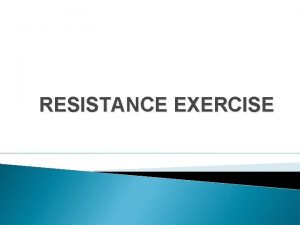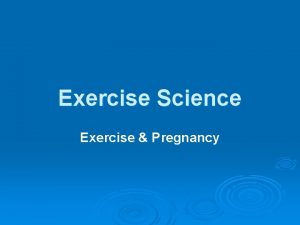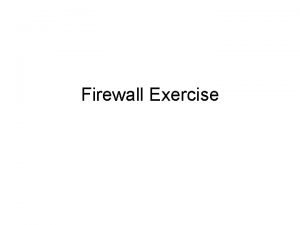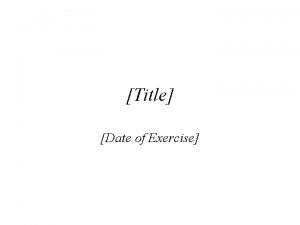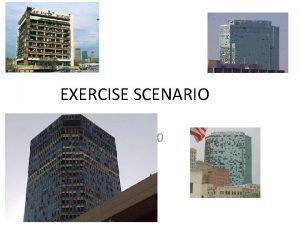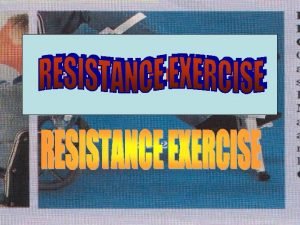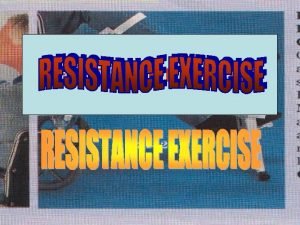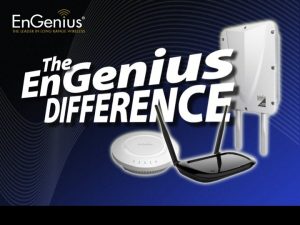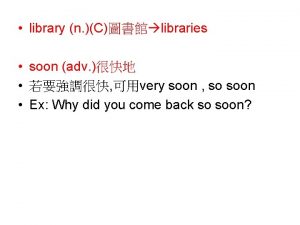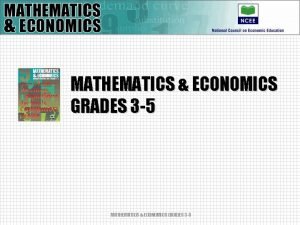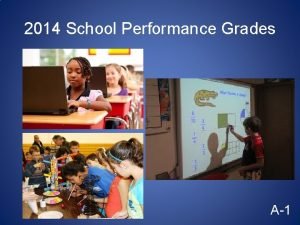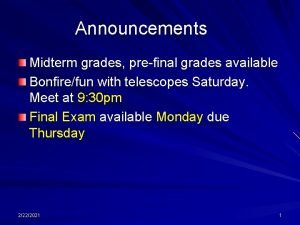Exercise 4 Soon Grades for 1 3 Soon

















![Lots of Approaches • • • visit frequency and reward gradient [Digney 1998], visit Lots of Approaches • • • visit frequency and reward gradient [Digney 1998], visit](https://slidetodoc.com/presentation_image_h/13febd26fc0e1c0c4c96c62b4dcd7b5e/image-18.jpg)













- Slides: 31

Exercise 4 • Soon… • Grades for 1 -3: Soon… ? • Class presentation: Next Tuesday to final Tuesday (28 th of this month)

Survey: S 14 • What were the best things about Matt making you lead one class discussion? • Good for presentation skills: 4 • Good for presenter to learn a topic in depth: 5 • Nice to see a selection of different topics: 1

Survey: S 14 • What were the worst things? • Some presenters were not prepared enough: 2 • Some topics were too advanced/technical for the point in the class or were hard to follow: 4

Survey: S 14 • Do you think Matt should do this next year? • • Yes: 7 Maybe: 1 Sure, why not? : 1 No: 0

Survey: S 14 • If Matt does it next year, how could he change it? • Require handout with takeaways and resources: 1 • Require more discussion / engagement: 3 • Better scheduling: avoid jumping around, avoid duplication (or group together): 2 • Be clear about using examples from exercises: 1 • Give a short presentation to Matt a week before. This will improve presentations and get more suggested readings: 1

Final Project Rubric Initial proposal (due next Wednesday, 1 -3 paragraphs on Piazza) Draft due on final day of class Final draft

Final Project Rubric Initial proposal (due next Wednesday, 1 -3 paragraphs on Piazza) Draft due on final day of class Final draft 20: Fully explained idea or question addressed (Why is it interesting? What’s the payoff if it works? ) 20: Experiments and/or theoretical work adequately addresses idea/question 20: Background & Related Work (Is it clear how this work is related to other things in the field? Is it clear what is/isn’t novel? ) 15: Conclusion and discussion of future work (What are the next steps for you, or others, who are interested in this? ) 10: Writing quality (scaled) 10: Presentation quality (Does this look like something you’d submit to a conference? )

• "Intrinsic motivation occurs when we act without any obvious external rewards. We simply enjoy an activity or see it as an opportunity to explore, learn, and actualize our potentials. " (Coon & Mitterer, 2010) • "Intrinsic motivation refers to the reason why we perform certain activities for inherent satisfaction or pleasure; you might say performing one of these activities in reinforcing in-and-of itself. " (Brown, 2007)

• Intrinsically Motivated Reinforcement Learning. Singh, Barto, and Chentanez • Slides modified from: A. Barto, Hierarchical Organization of Behavior, NIPS 2007 Workshop

The Usual View of RL Primary Critic

The Less Misleading View Primary Critic

Motivation • “Forces” energize an organism to act and direct its activity • Extrinsic Motivation: being moved to do something because of some external reward ($$, a prize, etc. ) • Intrinsic Motivation: being moved to do something because it is inherently enjoyable – Curiosity, Exploration, Manipulation, Play, Learning itself. . . Examples of intrinsic motivation? How/Why useful?

Robert White’s famous 1959 paper “Motivation Reconsidered: The Concept of Competence” Psychological Review, Vol. 66, pp. 297– 333, 1959 Critique of Hullian and Freudian drive theories that all behavior is motivated by biologically primal needs (food, drink, sex, escape, …) Either directly or through secondary reinforcement • Competence: an organism’s capacity to interact effectively with its environment • Cumulative learning: significantly devoted to developing competence

What is Intrinsically Rewarding? • • novelty • curiosity surprise • exploration salience • … incongruity manipulation “being a cause” mastery: being in control See D. E. Berlyne’s writings for more data and suggestions

An Example of Intrinsically Motivated RL Rich Sutton, “Integrated Architectures for Learning, Planning and Reacting based on Dynamic Programming” In Machine Learning: Proceedings of the Seventh International Workshop, 1990. – For each state and action, add a value to the usual immediate reward called the exploration bonus – … a function of the time since that action was last executed in that state. The longer the time, the greater the assumed uncertainty, the greater the bonus • Recall: Dyna-Q+ – Facilitates learning of environment model

What are features of IR? IR depends only on internal state components These components track aspects of agent’s history IR can depend on current Q, V, , etc. IR is task independent (where task is defined by extrinsic reward) • IR is transient: e. g. based on prediction error • … • Most have goal of efficiently building “world model” • •

Where do Options come from? • SMDP • Many can be hand-crafted from the start (and should be!) • How can an agent create useful options for itself?
![Lots of Approaches visit frequency and reward gradient Digney 1998 visit Lots of Approaches • • • visit frequency and reward gradient [Digney 1998], visit](https://slidetodoc.com/presentation_image_h/13febd26fc0e1c0c4c96c62b4dcd7b5e/image-18.jpg)
Lots of Approaches • • • visit frequency and reward gradient [Digney 1998], visit frequency on successful trajectories [Mc. Govern & Barto 2001] variable change frequency [Hengst 2002] relative novelty [Simsek &Barto 2004] salience [Singh et al. 2004] clustering algorithms and value gradients [Mannor et al. 2004] local graph partitioning [Simsek et al. 2005] causal decomposition [Jonsson & Barto 2005] exploit commonalities in collections of policies [Thrun & Schwartz 1995, Bernstein 1999, Perkins & Precup 1999, Pickett & Barto 2002] Many of these involve identifying subgoals

Creating Task-Independent Subgoals • Our approach: learn a collection of reusable skills • Subgoals = intrinsically rewarding events

A not-quite-so-simple example: Playroom Singh, Barto, & Chentanez 2005 Agent has eye, hand, visual marker Actions: move eye to hand move eye to marker move eye to random object move hand to eye move hand to marker move marker to eye move marker to hand If both eye and hand are on object: turn on light, push ball, etc. 20

Playroom cont. Switch controls room lights Bell rings and moves one square if ball hits it Press blue/red block turns music on/off Lights have to be on to see colors Can push blocks Monkey laughs if bell and music both sound in dark room 21

Skills • To make monkey laugh: – – – – Move eye to switch Move hand to eye Turn lights on Move eye to blue block Move hand to eye Turn music on Move eye to switch Move hand to eye Turn light off Move eye to bell Move marker to eye Move eye to ball Move hand to ball Kick ball to make bell ring • Using skills (options) – – Turn lights on Turn music on Turn lights off Ring bell

Option Creation and Intrinsic Reward • Subgoals: events that are “intrinsically interesting. ” Here, unexpected changes in lights and sounds • On first occurrence, create an option with that event as subgoal • Intrinsic reward generated whenever subgoal is achieved: – Proportional to the error in prediction of that event (“surprise”)… decreases with experience – Use a standard RL algorithm with R=IR+ER • Previously learned options are available as actions for learning policies of new options (primitive actions always available too)

Reward for Salient Events Lights Sound (bell) Music Monkey

Speed of Learning Various Skills

Learning to Make the Monkey Laugh

Shortcomings • • • Hand-crafted for our purposes Pre-defined subgoals (based on “salience”) Completely observable Little state abstraction Not very stochastic No un-caused salient events “Obsessive” behavior toward subgoals Tries to use bad options More

Connectivity of Playroom States Light on Music on Noise off Light off Music off Noise off Light on Music on Noise on Özgür Şimşek Light off Music on Noise off Light off Music on Noise on

Conclusions • Need for smart adaptive generators • Adaptive generators grow hierarchically • Intrinsic motivation is important for creating behavioral building blocks • RL+Options+Intrinsic reward is a natural way to do this • Development! • Theory? • Behavior? • Neuroscience?

• Intrinsically Motivated Reinforcement Learning: An Evolutionary Perspective. Singh, Lewis, Barto, and Sorg • Intrinsically Motivated Reinforcement Learning: A Promising Framework For Developmental Robot Learning. Stout, Konidaris, and Barto

What’s next? Please pick 1 -5 1. 2. 3. 4. 5. 6. 7. 8. 9. 10. 11. 12. 13. 14. 15. 16. Transfer Learning / lifelong learning: 2 Learning from Demonstration: 1 Multi-agent RL: 3 Options & Option Learning: 2 Game Playing: 2 Inverse Reinforcement Learning (IRL): 1 Learning in Robotics: 4 Meta-RL and empirical evaluation of algorithms: 1 Hierarchical Methods: 2 Case Studies: Robot soccer, Helicopter Control, etc. : 4 Adaptive Representations / Representation Learning: Partially observable environments and/or POMDPs: 1 Current Function Approximation Choices: 1 Efficient Model-Learning methods: 3 Other advanced RL methods (e. g. , LSPI, policy gradient, etc. ): 3 Crowd Sourcing: 1
 King jesus is coming
King jesus is coming Rita perspektiv
Rita perspektiv Toppslätskivling dos
Toppslätskivling dos Debattinlägg mall
Debattinlägg mall Redogör för vad psykologi är
Redogör för vad psykologi är En lathund för arbete med kontinuitetshantering
En lathund för arbete med kontinuitetshantering Geometri för barn
Geometri för barn Claes martinsson
Claes martinsson Dikt bunden form
Dikt bunden form Offentlig förvaltning
Offentlig förvaltning Vad kallas den mantel som bars av kvinnor i antikens rom
Vad kallas den mantel som bars av kvinnor i antikens rom Vilken grundregel finns det för tronföljden i sverige?
Vilken grundregel finns det för tronföljden i sverige? Bamse för de yngsta
Bamse för de yngsta Verktyg för automatisering av utbetalningar
Verktyg för automatisering av utbetalningar Förklara densitet för barn
Förklara densitet för barn Ministerstyre för och nackdelar
Ministerstyre för och nackdelar Sju principer för tillitsbaserad styrning
Sju principer för tillitsbaserad styrning Vem räknas som jude
Vem räknas som jude Tack för att ni lyssnade bild
Tack för att ni lyssnade bild Nyckelkompetenser för livslångt lärande
Nyckelkompetenser för livslångt lärande Ro i rom pax
Ro i rom pax Vad är verksamhetsanalys
Vad är verksamhetsanalys Gibbs reflekterande cykel
Gibbs reflekterande cykel Autokratiskt ledarskap
Autokratiskt ledarskap Borstål, egenskaper
Borstål, egenskaper Cks
Cks Kassaregister ideell förening
Kassaregister ideell förening Shivaismen
Shivaismen Kyssande vind analys
Kyssande vind analys Inköpsprocessen steg för steg
Inköpsprocessen steg för steg Expektans
Expektans Strategi för svensk viltförvaltning
Strategi för svensk viltförvaltning

































